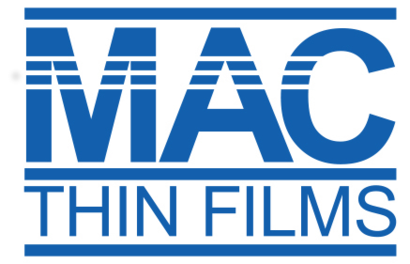North Bay Business Journal - JDSU thin-film optics unit relaunches as startup
SANTA ROSA -- Sometimes one company’s castoffs become another’s golden opportunity.
MAC Thin Films, a startup forged out of technology formerly owned by JDSU’s Santa Rosa unit, makes antireflective and mirror coatings used in laser printers, scanners, on custom displays for air-traffic controllers, medical imaging, avionics and in military applications where LCD displays have to operate correctly and instantly despite challenging temperatures or humidity.
MAC Thin Films launched as an autonomous, privately held corporation in April, started manufacturing in June, hit full stride in early November and expects worldwide revenue of $10 million in its first year. The company has 45 employees. About two-thirds of sales are international, and roughly a quarter of the sales go toward military applications.
“There were some parts of the operation that had to be relocated,” said Mark Madigan, CEO of the Santa Rosa-based company that leased a building from JDSU.
Other operations stayed put. “There is nothing to be gained by moving equipment,” he said.
MAC Thin Films makes the Multi-layer Automatic Coater system that was initially designed in 1970 to provide antireflective and front-surface mirrors.
“It was the first high-performance, multilayer continuous optical coating system of its kind. Its products are in use around the globe,” said Mr. Madigan. The high-end displays “require the best in visual acuity,” he said, as well as electromagnetic shielding.
“The ability to start a plane up in a cold climate instantly requires certain coatings that we provide,” Mr. Madigan said. “LCDs, because they are liquid, don’t work well when they are very, very cold. We’re providing a front optical filter that is integrated with the LCD, allows the LCD to come on very quickly -- almost instant on. That’s important for avionics displays.”
The company’s coating technology also helps in medical applications. “Some of our key customers are leaders in medical imaging,” Mr. Madigan said, for mammography and radiography, which are done with high-resolution digital displays. MAC Thin Films technology makes the displays easier to see. Some of the company’s customers use 10-megapixel screens that are higher resolution than typical HD televisions. “We sell a piece of glass that has various coatings applied to it,” he said, “and other treatments that provide electrical conductivity or connection. Then that’s integrated into a display unit.”
The MAC coating machine supports many glass sheet sizes. Coating solutions are optimized for specific applications to provide uniform anti-reflection performance over a broad range of wavelengths and maximize energy throughput.
“JDSU had shut the operation down,” Mr. Madigan said, because it was not part of the company’s investment plan. “We bought the equipment” in an asset purchase and restarted operations. The owners are a handful of investors both on the supply and customer side, he said.
Mr. Madigan was director of sales and marketing for one of the JDSU units in Santa Rosa.
JDSU agreed to provide technical support services for six months to ensure a smooth transition.JDSU to bifurcate in 2015
As reported here in September, telecommunications equipment maker JDSU expects in the third calendar quarter of 2015 to split into two publicly traded companies in efforts to jolt its tepid growth. JDSU is headquartered in Milpitas but still has significant operations in southwest Santa Rosa.
The company has about 400 employees in Santa Rosa, many of whom work on special technology used to make currencies worldwide more difficult to counterfeit.
JDSU has market capitalization of about $2.8 billion. The bifurcation should save about $50 million in costs, the company estimated. JDSU shareholders will receive a pro rata distribution of shares in the stand-alone company via a tax-free spinoff.
The company sells its products to telecommunications companies and big data managers.
Thomas Waechter will remain CEO of the main JDSU company, while Alan Lowe, president of the components division, will be chief executive of the spinoff business.
The original MAC Thin Films technology was the brainchild of inventor Rolf Illsley, who founded Optical Coating Laboratory, Inc. in Santa Rosa in 1963. OCLI, which made thin-film optical products including parts for copiers, a line of sunglasses and optically variable pigment used in paper currencies worldwide, was merged into JDS Uniphase in 2000.
Mr. Madigan worked with Mr. Illsley.
“He was a real entrepreneur,” Mr. Madigan said of Illsley.
MAC Thin Films is named after “an iconic coating machine that Rolf was the driving force behind,” Mr. Madigan said. “He was the guy who wanted to do something revolutionary. It still has unique capabilities, is still an economically viable platform.”


Nathan Chambers
Author